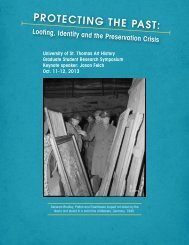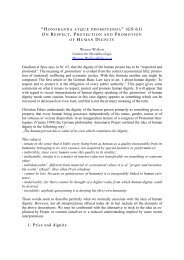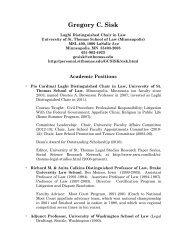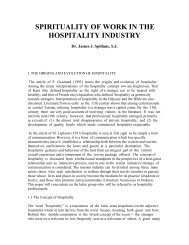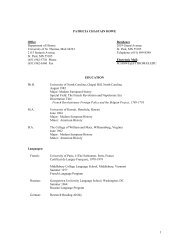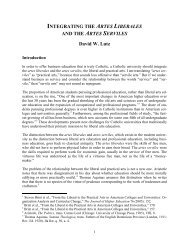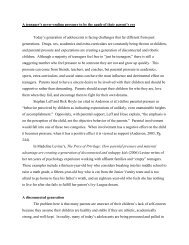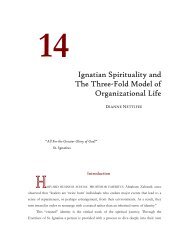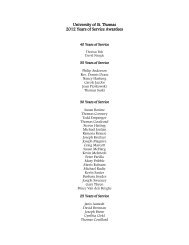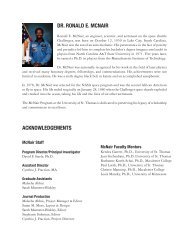McNair Research Journal - University of St. Thomas
McNair Research Journal - University of St. Thomas
McNair Research Journal - University of St. Thomas
Create successful ePaper yourself
Turn your PDF publications into a flip-book with our unique Google optimized e-Paper software.
Humanities & Social Sciences<br />
A Qualitative Analysis <strong>of</strong> Asian-American Attitudes<br />
Towards Interracial Romantic Relationships<br />
Amy S. Westmoreland and Buffy Smith Ph.D.<br />
<strong>University</strong> <strong>of</strong> <strong>St</strong>. <strong>Thomas</strong> - Departments <strong>of</strong> Psychology & Criminal Justice<br />
Abstract<br />
Previous literature surrounding race relations within the United <strong>St</strong>ates has<br />
uncovered a bounty <strong>of</strong> innovative and intriguing findings. However, regardless<br />
<strong>of</strong> the strides social researchers have made, research surrounding race relations<br />
as a whole remains underdeveloped and <strong>of</strong>ten leaves its readers with more<br />
questions than answers. One <strong>of</strong> the questions the present study attempts to<br />
answer is the following: What are the attitudes <strong>of</strong> interracial and intraracial<br />
college friendships among Asian-Americans toward interracial romantic<br />
relationships? Overall, the primary theoretical basis for the present study is<br />
based on Gordon Allport’s (1954) social contact hypothesis or the notion that<br />
interaction between members <strong>of</strong> different racial groups can lead to positive<br />
racial attitudes. Past research has identified that attitude formations towards<br />
interracial dating and marriage are partly dependent on the respondents’<br />
current and past history <strong>of</strong> interracial and intraracial friendships. Therefore,<br />
interracial vs. intraracial friendships serves as the primary predictor variable<br />
hypothesizing that Asian-American respondents who engage in interracial<br />
friendship develop more positive racial attitudes toward interracial romantic<br />
relationships than respondents who primarily engage in intraracial friendships.<br />
Additional predictor variables examine the respondents’ gender, age, socioeconomic<br />
status (SES)/educational attainment, and propinquity/homophily.<br />
Introduction<br />
In 1967, the United <strong>St</strong>ates Supreme Court legalized interracial marriages<br />
(Loving v. Virginia). Over three decades later, the U.S. Census reported<br />
a gradual increase in interracial marriages from representing 0.7 percent<br />
<strong>of</strong> all marriages in the year 1997 to representing 4.9 percent <strong>of</strong> all<br />
marriages in the year 2000. However, regardless <strong>of</strong> the ongoing increase<br />
<strong>of</strong> interracial marriages, individual attitudes towards interracial romantic<br />
relationships continue to reflect the controversial nature <strong>of</strong> interracial<br />
dating and marriage within modern society.<br />
Previous literature surrounding the topics <strong>of</strong> interracial dating and<br />
marriage has uncovered a wealth <strong>of</strong> intriguing findings. However, due to<br />
the lack <strong>of</strong> research, particularly among Asian-American populations,<br />
studies attempting to dissect attitudes towards interracial romantic<br />
relationships <strong>of</strong>ten leave readers with more questions than answers. The<br />
present study contributes to the existing literature by asking the following<br />
question: What are the attitudes <strong>of</strong> interracial and intraracial college<br />
friendships among Asians-Americans towards interracial romantic<br />
relationships? The main hypothesis for the study suggests that Asian-<br />
American students who engage in interracial friendships develop more<br />
positive racial attitudes toward interracial romantic relationships than<br />
those students who primarily engage in intraracial friendships.<br />
The present study will provide an overview <strong>of</strong> the literature, conceptual<br />
framework, methodology, and preliminary results. Finally, the concluding<br />
section will provide an argument for the significance <strong>of</strong> the study.<br />
Literature review<br />
Past research has identified that attitude formations in support <strong>of</strong> interracial<br />
romantic relationships are not only dependent on the respondents’<br />
current and past history <strong>of</strong> interracial friendships, but also dependent on<br />
other forms <strong>of</strong> interracial interactions such as, living in a racially heterogeneous<br />
neighborhood and attending a racially heterogeneous school. For<br />
the purpose <strong>of</strong> the present study, I analyzed Asian-American attitudes<br />
Amy S. Westmoreland<br />
Interracial Romantic Relationships<br />
toward interracial romantic relationships by focusing on the following five<br />
predictor variables: trends in interracial relationships, propinquity/<br />
homophily, socioeconomic status (SES)/educational attainment, gender,<br />
and age.<br />
Trends in Interracial Relationships<br />
Based on previous studies, individuals regardless <strong>of</strong> race or ethnicity are<br />
more likely to have a racially homogenous circle <strong>of</strong> friends (Mouw &<br />
Entwisle, 2006; Way & Chen, 2000). In addition, first-listed or best<br />
friends are more likely to share the same race or ethnicity and engage in<br />
more weekly activities together than fifth-listed friends (Kao & Joyner,<br />
2004). The latter finding suggests that interracial best friends are not only<br />
uncommon, but also engage in fewer weekly activities together which<br />
could be interpreted as less intimacy and a greater degree <strong>of</strong> distance<br />
(Kao & Joyner, 2004). However, when individuals cross racial lines in<br />
terms <strong>of</strong> who they choose as friends, they are more likely to have a diverse<br />
group <strong>of</strong> friends in the future (Emerson, Kimbro & Yancey, 2002) and are<br />
more likely to approve <strong>of</strong> interracial marriages (Jacobson & Johnson,<br />
2006) when compared with individuals who do not choose friends <strong>of</strong><br />
another race or ethnicity.<br />
In terms <strong>of</strong> interracial romantic relationships, it is important to establish<br />
the distinction between dating and marriage. When forced to consider the<br />
degree <strong>of</strong> commitment involved in a marriage, interracial marriages tend<br />
to be less common than interracial dating (Joyner & Kao, 2005). Specifically<br />
focusing on Asian-Americans, past research has uncovered a decline<br />
in interracial marriages accompanied by an increase in interethnic<br />
marriages (Lee & Fernandez, 1998). This finding may be attributed to the<br />
growing population <strong>of</strong> Asian-Americans within the United <strong>St</strong>ates. Other<br />
findings have revealed that when Asian-Americans marry someone <strong>of</strong><br />
another race, they are more likely to marry a Non-Hispanic White than<br />
any other racial group (King & Bratter, 2007; Mok, 1999). Furthermore,<br />
Asian-American friendships are positively related to one’s likelihood to<br />
date a fellow Asian-American and negatively related to one’s likelihood to<br />
date a White-American (Mok, 1999). In other words, the fewer intraracial<br />
friendships among Asian-Americans increases the likelihood <strong>of</strong> dating a<br />
White-American.<br />
However, one important factor excluded from past studies is whether<br />
attitudes towards interracial dating and marriage differ among transracially<br />
adopted and non-adopted Asian-Americans. The present study will<br />
address this past limitation by examining how being raised by parents who<br />
share a similar racial background versus parents who share a different<br />
racial background influences an individual’s attitude towards interracial<br />
romantic relationships.<br />
In sum, previous research have uncovered that individuals are more<br />
likely to befriend, date and marry others who share their same racial or<br />
ethnic background (Joyner & Kao, 2005; Kao & Joyner, 2004; Lee &<br />
Fernandez, 1998; Mouw & Entwisle, 2006; Way & Chen, 2000)<br />
However, when individuals cross racial lines, they are far more likely to<br />
support interracial romantic relationships if they have experienced previous<br />
interracial contact (e.g., interracial friendships) (Joyner & Kao, 2005;<br />
Mok, 1999). In the following section I will expand on how interracial<br />
interaction is influenced by propinquity and homophily.<br />
60 <strong>University</strong> <strong>of</strong> <strong>St</strong>. <strong>Thomas</strong> <strong>McNair</strong> <strong>Research</strong> <strong>Journal</strong>



